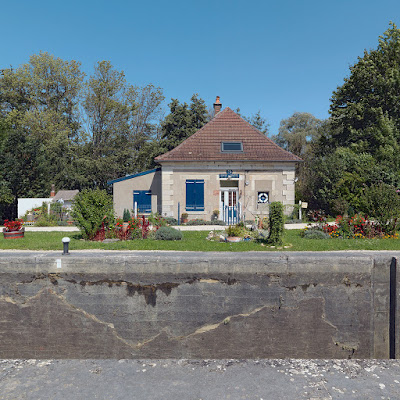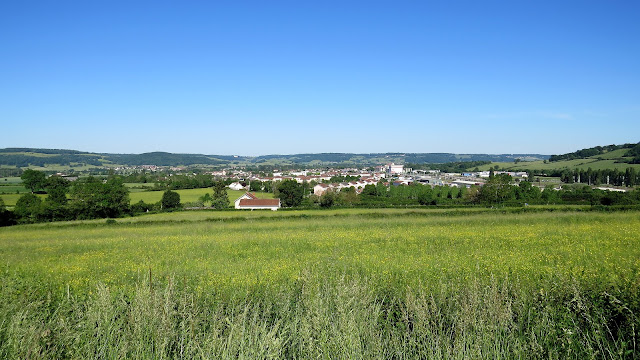1
June to 4 June 2019. 35 kilometers, 51 locks.
 |
| This is what 35 kilometers and 51 locks look like. Each step is a lock. |
Saturday 1 June. Montbard to Veneray-les-Laumes. 13
kilometers, 9 locks, 3 hours, 15 minutes.
One of the
fascinating aspects of cruising the French waterways is spotting the various
lockkeepers cottages, some beautifully and tastefully restored, some restored
by gnomes, goblins, frogs and other assorted statuary, and some completely dilapidated.
The owners of the Vermenton base had told us that the VNF only allow a maximum
lease of five years and one is not compensated for any improvements to the
property which makes moving into a fixer-upper a bit of a dubious proposal.
What we did not
know is that there are essentially different genres of buildings on the Burgundy Canal: lockkeeper houses, collection
(tax?) offices, guard houses and engineers’ dwelling structures. Other
canals have more uniformity but because of the timespan over which the Burgundy
was built several people influenced the style of building.
The waterway has 222
houses, most of which are lockkeepers homes, divided into the following styles:
141 of Foucherot
type
 |
| Lock house on the Yonne side of the river at Mussy-la-Fosse. |
41 of type Forey
 |
| Lock house of the reach 75 of the Saônside, in Brazey-en-Plainee |
15 of the type
Poirée
 |
| Lock house on bief 87 at Argentenay |
10 of type
Robillard
 |
| Lock house on the Yonne side of the river at Saint-Florentin |
2 of type Montfeu
 |
| Lockkeeper house on the bief at Brienon-sur-Armancon. |
and 7 atypical,
combining more than one function
All this and more
fascinating information can be found at the website Itinéraire numérique descanaux de Bourgogne (use Google Transate unless your French is up to it).
But we didn’t
notice any lockkeepers houses on this stretch. A minute or two after nine our
first lady lockie arrived and, expertly and quickly, locked us through. And
this was repeated for all the remaining locks; at one stage we had three
lockkeepers working together and we sensed that they were happy with our
lock-through competence and were determined to get us to Venarey before their midday
lunchtime stop – we exited the last of the nine locks at eleven fifty-nine!
 |
| Chalkhill Blue II waiting to enter the lock. |
 |
| And in they go. |
 |
| Only one pound was clogged with weed - we had to clear props twice. |
June 1 and summer
has arrived with a vengeance; the spiders have been spinning webs frantically
to make up for the cold days before, and the temperature inside the saloon
rising to 37C.
Our mooring,
adjacent to a Nicols hireboat base, is Spartan being at the end of a stone wall
behind two restoration-in-progress barges.
 |
| We're the white blob in the distance. |
 |
| The original wooden rudder had rotted so they sculpted this one based on a little floating whale they have in their bathroom. |
 |
| Looking back down the canal. |
There is nothing much to Venarey, and
Les Laumes, on the eastern side of the canal, is a town essentially established
at the end of the nineteenth century when the large railway marshaling yards
were built.
 |
| The main road through Les Laumes. |
 |
| The huge station. |
 |
| Looking down from above. |
Nearby however, is the site at which Vercingetorix, the first
leader of a combined Gaul force which forced Caesar to withdraw from Gaul, was
defeated by Caesar in 52BC. He is still considered to be the first leader of
France.
We made the
pilgrimage to the delightful village of Alise-Sainte-Reine up a steep hill
 |
| Joan wos 'ere. |
 |
| The roofs of Alise-Sainte-Reine |
and
then up some even steeper steps to the statue of Vercingetorix then returned to
the bikes and set off in search of the remains of the Gallo-Roman village; the
way is clearly marked (up another steep hill – I pushed my bike to conserve
battery and I’m sure I heard the grave-tending lady in the cemetery ask Lynn if
she was looking for a vacant space as it looked as if I might need it soon) and
barely one hundred meters away was the statue which we had toiled so hard to
reach.
 |
| Lynn, a supporter of Vercingetorix. |
Because of a bit of confusion in the signage, we did not pay to go
inside the site of the ruins and for the same reason did not visit Le MuséoParc
Alésia, an interpretative center built on the place where, purportedly, the
last battle between Vercingetorix and the Romans took place.
By mid-afternoon
the previously deserted port had six hireboats and one Piper barge (Quercy)
moored against its walls, and another Piper, Rangali, came in and moored
up behind us.
 |
| The port on our first morning. |
 |
| And the next morning. |
Monday 3 June. Venarey-les-Laumes to
Marigny-le-Cahouët. 11.6 kilometers, 29 locks, 6 hours, 15 minutes (including
one hour for lunch tied up in a lock).
Dressed in beach
wear and expecting another warm day, we set off the short distance to the first
lock just before nine; by the time we exited, there were banks of black cloud
rapidly approaching and in the distance could be heard the sound thunder
accompanied by quick flashes of lightning.
 |
| Ominous. |
Lynn just had time to scurry
downstairs and grab a weatherproof jacket before the heavens opened and the
temperature plummeted – and so it remained through the next six kilometers and
fifteen locks,
 |
| The windscreen wiper kept on getting in the way. |
 |
| Windscreen wiper off... |
and then typically, as we tied up for lockie-lunchtime, it
cleared, the sun popped out and the temperatures climbed.
 |
| Locked in fpr lunch. |
By now Lynn was fully
kitted out in long sleeves, goosedown jacket, oilskin pants and wellies, this
attire lasting two more locks until the wellies, pants and jacket were discarded
– now, instead of being freezing cold and wet, Madame was boiling hot but no
time between locks to get rid of the tracksuit pants and long-sleeved top.
After lock number one,
we had a girl-guy combination of lockies who were really great
and who whisked
us through until the twenty-fourth lock when the guy (reluctantly) was replaced
by a team of four which had us a record five lockkeepers to do the last five locks
– and did we then get a move on. Drive in, hit the brakes, one door closes,
assistance with lines and then other door closes, both sluices opened, engines
used for stabilization, doors whacked open (two on each door) and out we go and
almost directly into the next lock. Fifteen locks in the three hours before
lunch and another fourteen after lunch in just over two hours – not bad going
even if we say so ourselves!
 |
| A lock followed by a lock. |
 |
| Lock-side summer flowers. |
Tomorrow we share thirteen
locks over twelve kilometers with Mon Amie which is moored in front of
us.
 |
| Shallow at the sides. |
Later that evening
we hear a knock on the window and, lo and behold, there are two people from a
campervan parked a few meters away who are/were/could be South Africans. Let me
explain: Linda was born in Durban, married an English passport holder, moved to
the UK, acquired British citizenship, her late husband preferred France so they
bought a house in a village somewhere in the center of the country where he
eventually passed away but where she still lives having acquired French
permanent residence. She speaks with a strong SA accent and says that her
French is still very poor. Kevan lives in Pretoria but is a British citizen and
still speaks with a strong English (not sure which county) accent. They spend
six months in France and six months in South Africa together.
 |
| Flying the colours. |
Tuesday 4 June. Marigny-le-Cahouët to Pont Royal. 11.7
kilometers, 13 locks, 3 hours, 30 minutes.
A lovely warm and
lightly clouded morning, by eight the big raindrops had started falling. Only a
teaser though and as the single black cloud moved on it turned into a glorious
but breezy day.
We agreed with Mon Amie that they would do the first six locks in front and that we would swop and do the last seven – no-one likes to
be in front in ascending locks. There was a slight change of plan brought on by
them being stuck hard and fast and, despite their best efforts they simply
could not extricate themselves. We then tried pulling them off sternwards which
didn’t work but a hard ahead, oblique tug pried them loose leaving us ahead of
them anyway so we said we would go up-lock first and that’s the way it stayed
through all thirteen locks. We lent them our “ladder hook” for which they were
most grateful and they admired Lynn’s “TV antenna” bollard lassoing gadget.
 |
| Our traveling companions. |
 |
| Levels are low but we are managing comfortably but leave a trail of mud wherever we go. Like driving a bakkie on a dirt road. Mon Amie, at 1.2m are also managing. |
 |
| The water levels don't detract from the beauty of the waterway. |
 |
| Lynn playing figurehead - and keeping the stern a bit higher. |
Luckily for us,
the lockkeeper at lock number fourteen (our one hundredth on this canal)
decided to lock us through even although we only arrived at ten past twelve,
and a couple of minutes later we were safely tied up in the lovely country port
of Pont Royal – a grand name for a very simple village. At €12 for two
nights, water and electricity included, it’s a gift.
 |
| Port de Plaisance Pont Royal - superb! |
 |
| The Capitainerie and hotel. |


















Great website. Well found!
ReplyDeleteIsn't it just. I was thinking you could use it in the next eNewsletter.
DeleteGreat info on the lock cottages Shaun. Thanks
ReplyDeleteA pleasure!
DeleteVercingetorix: now I know where Uderzo et al got their ideas for Asterix and Obelix
ReplyDelete